- Home
- Garden Wildlife
- Insects
- Dragons/damsels
- Dragonflies
Dragonflies
Dragonflies are insects in the order Odonata, sub-order Anisoptera. They include some of our largest insects by wing span. Dragonflies are generally bigger, more stoutly built and and much stronger fliers than the related damselflies. They are therefore more likely to be seen hunting away from ponds and rivers. Jennifer Owen recorded six species in her garden study, all included below. See our introduction page for more on the biology of these attractive insects.
Species in Britain and Ireland
There are about 30 species of dragonflies in Britain and Ireland. As with damselflies, many species require lakes or running water for breeding, so only a few species can breed in gardens, although some of the other species may visit occasionally.
Southern hawker Aeshna cyanea
This large dragonfly is common in England and Wales, and often seen in gardens from May to early November. They have two large light green patches on the front of the thorax. Females are green and dark brown, while the males have blue, green and black. Note that this genus used to be spelled as "Aeschna"
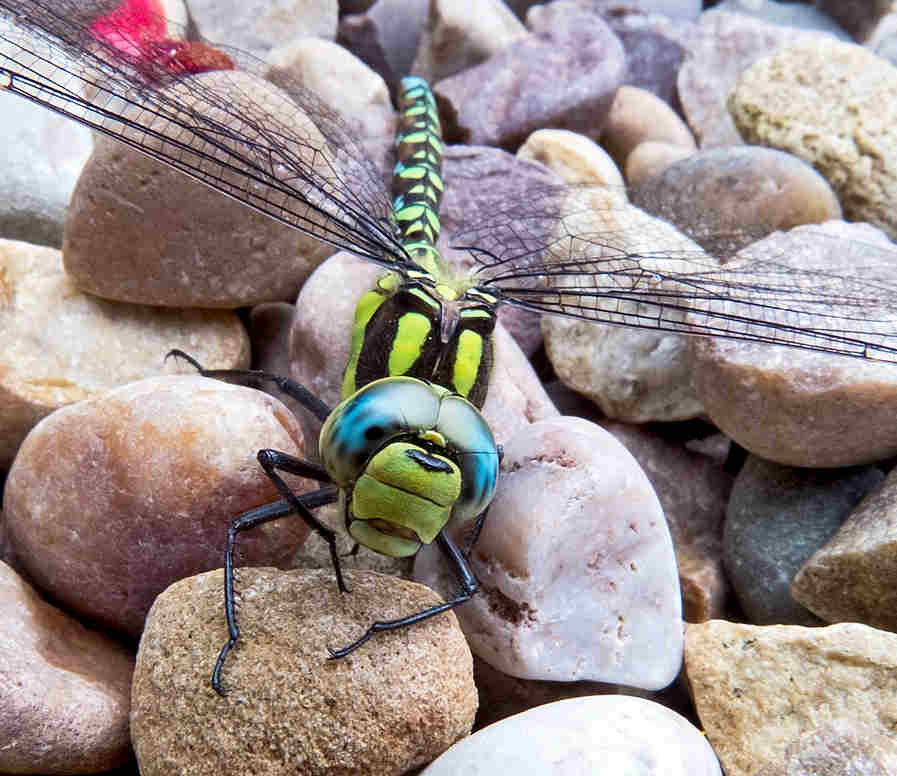
Emperor dragonfly Anax imperator
This is our largest dragonfly, mainly found in the south of England and Wales, but its range is expanding north and into Ireland. The male is bright blue and female green. They spend up to 2 years as larvae and grow big enough to catch tadpoles and small fish. Adults fly from May to October, and seldom settle, feeding on the wing. The abdomen tends to droop in flight which helps identification.
Other sources of information
Websites
Website of the British Dragonfly Society
Steve Falk's pages and information on odonata.
Facebook group UK Dragonflies and damselflies
Facebook Group British Butterflies Moths and Dragonflies
Natural England leaflet on dragonflies and damselflies
Books
Smallshire, D and Swash, A (2018) Britain's Dragonflies: A Field Guide to the Damselflies and Dragonflies of Great Britain and Ireland. Wild Guides
Brooks, S., Cham, S. and Lewington, R. (2018) Field Guide to the dragonflies and damselflies of Great Britain and Ireland. Bloomsbury Wildlife Guides
Cham, S. (2012) Field Guide to the larvae and exuviae of British Dragonflies - Dragonflies (Anisoptera) and Damselflies (Zygoptera). British Dragonfly Society
Corbet, P. & Brooks, S. (2008) Dragonflies Collins New Naturalist series no 106. Harper Collins
Page text drafted by Andrew Halstead, reviewed by Andrew Salisbury, compiled by Steve Head
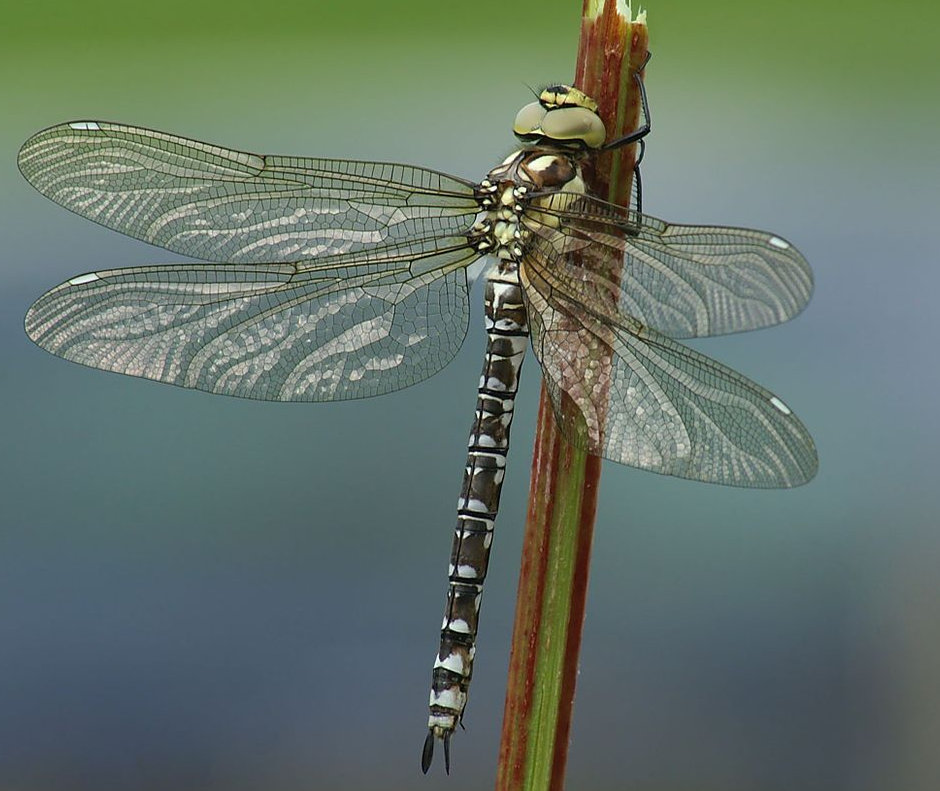
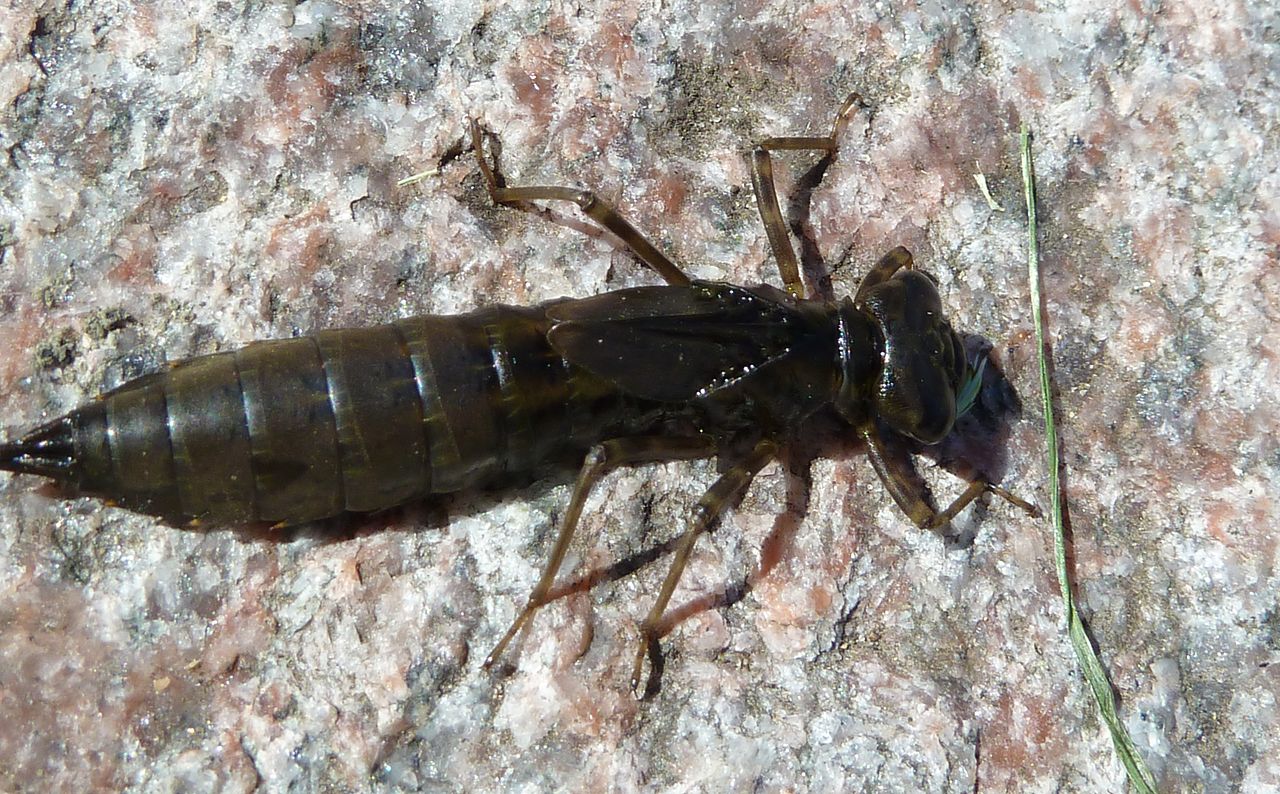
Southern hawker Aeshna cyanea
Top left: Male showing light green thorax patches
Top Right: Female
Left: Larva
Brown hawker Aeshna grandis
Another large dragonfly distinguished by its light-brown tinted wings and rather plain brown body. Found in southern and eastern England and across Ireland, flying from July to October. Males have a little blue on their abdomen, just in front of a curious "waist"
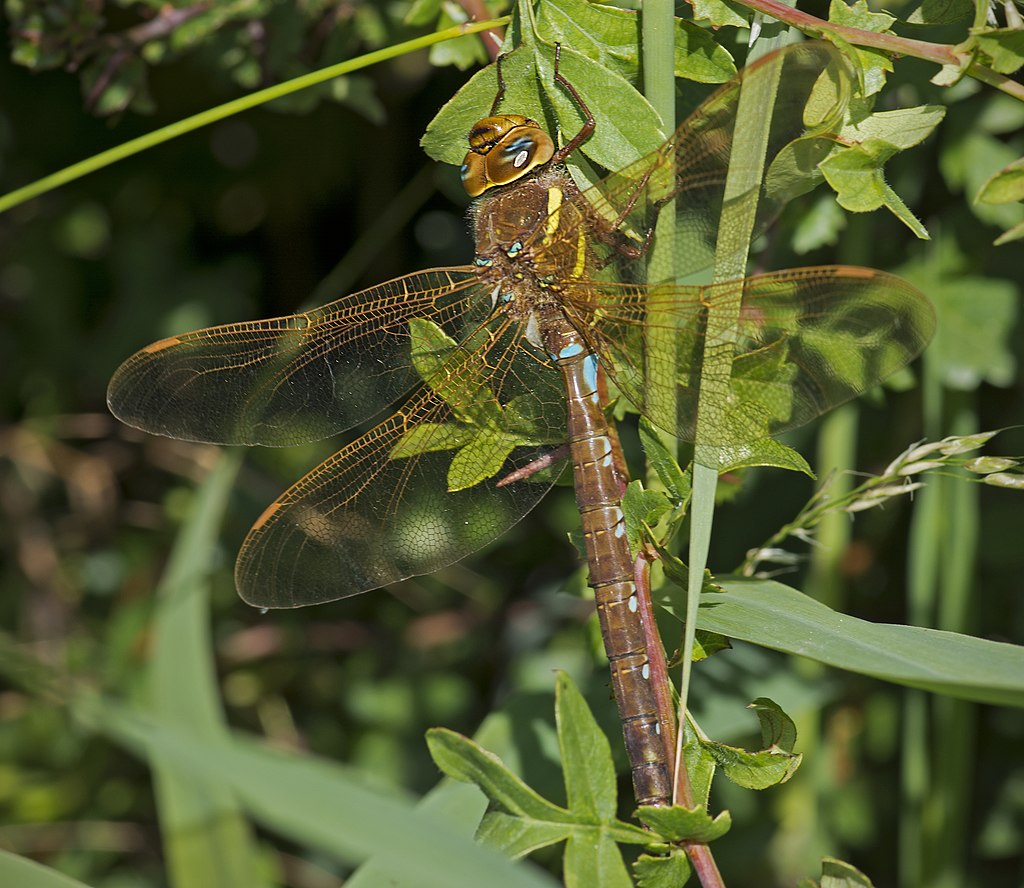
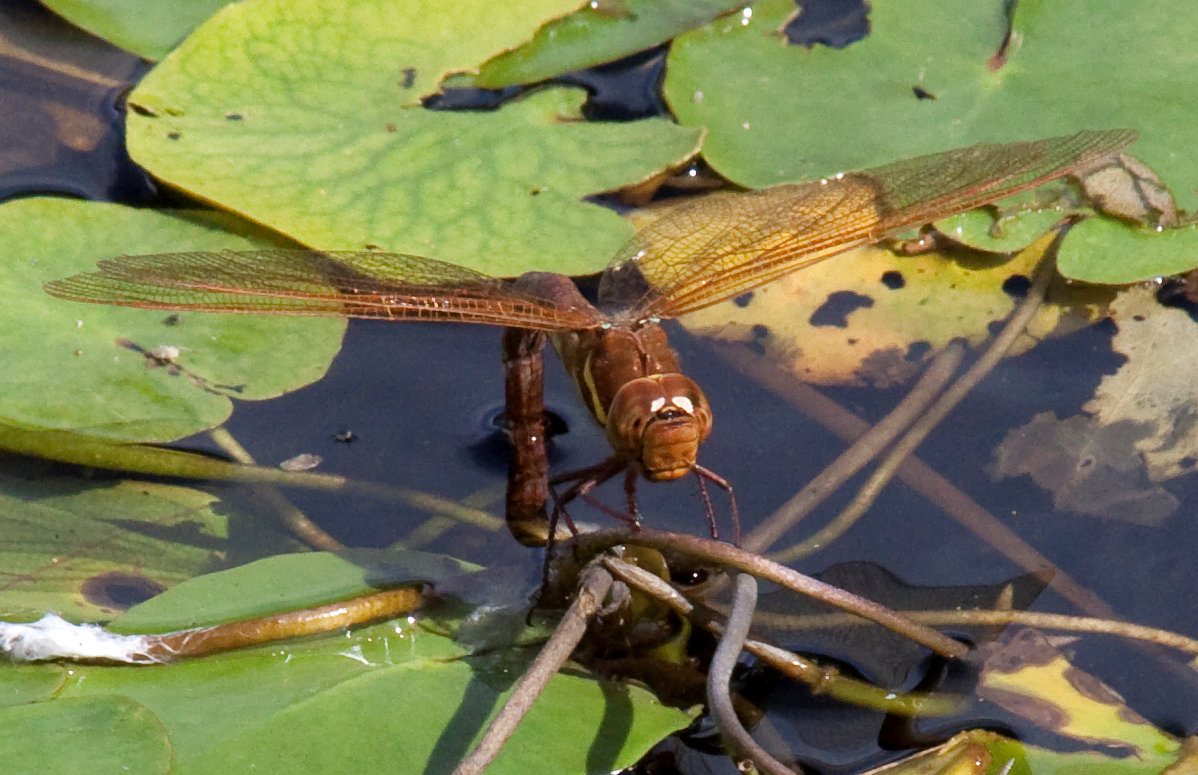
_larva.jpg)
Brown hawker Aeshna grandis
Top left: Male showing blue thorax patches and "waist"
Top Right: Female laying eggs - the brown wih colour is clear.
Left: Nymph. Dragonfly nymphs have relatively short cerci compared with damselflies.
Migrant hawker Aeshna mixta The smallest of our garden hawker dragonflies, but often very common, flying in July to November. Both sexes are brown, with the female having yellow spots and the male blue. Both sexes have an extended yellow mark the shape of a golf tee at the front of the abdomen. Found in lowland England and Wales and south Ireland, and its range is expanding north
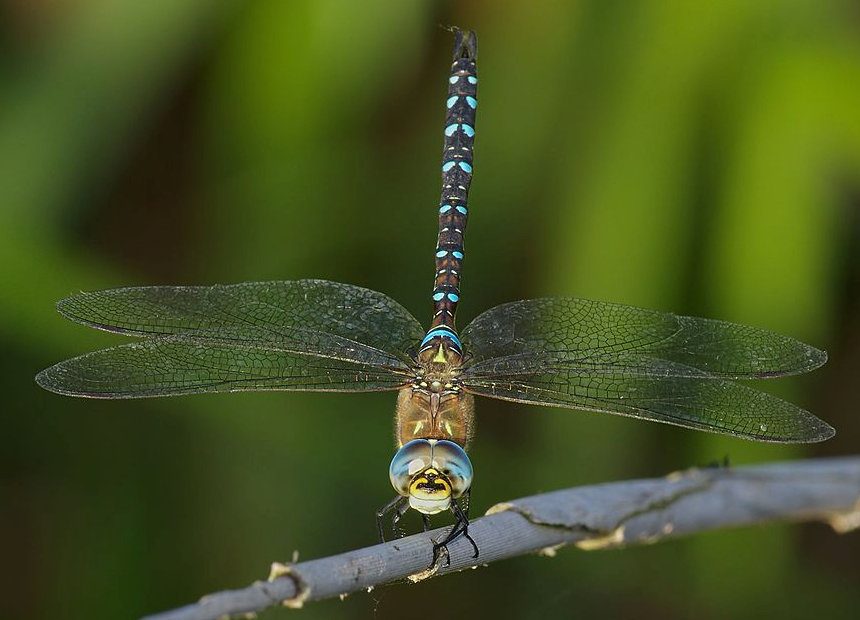
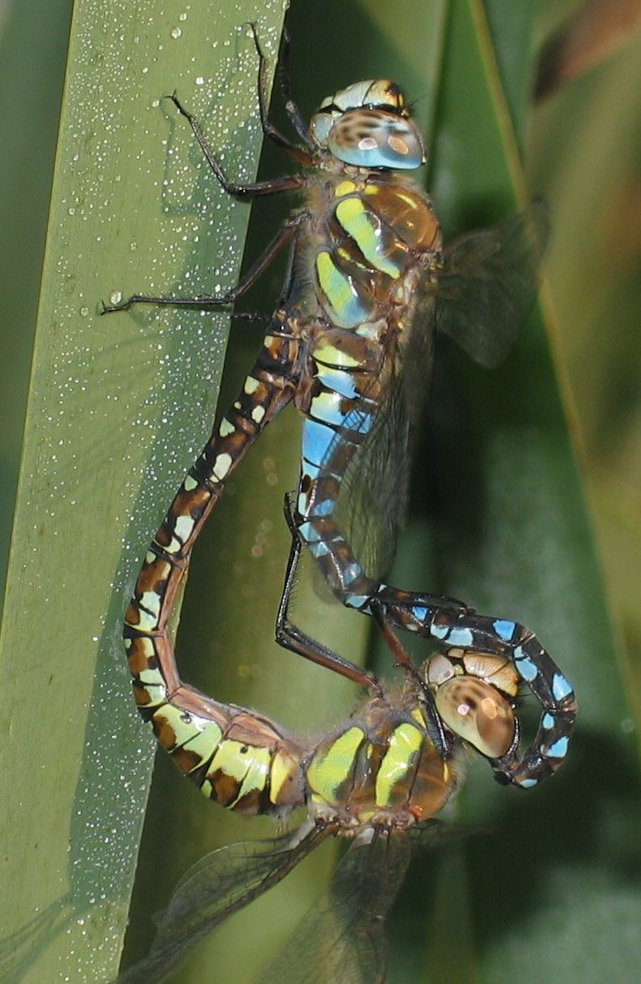
Migrant hawker Aeshna mixta. Left: male Right: mating pair, the male clasping the female's head with the tip of its abdomen, while the female takes sperm from the male's abdomen.
Common darter Sympetrum striolatum.
This is a very common smaller dragonfly. As the name implies, they tend to fly out from a resting spot rather than "hawking" - looking for prey in flight. They are seen from May to December, and their numbers are boosted by late summer migrants from Europe. Mature males orange-red and females olive green, but both are yellow-brown as young adults.
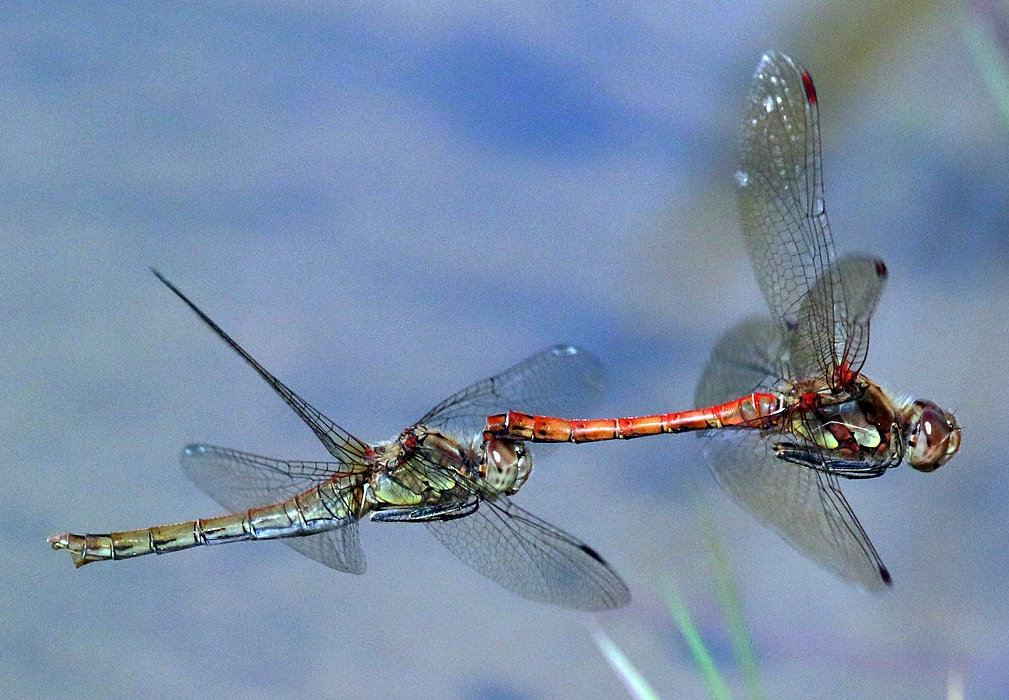
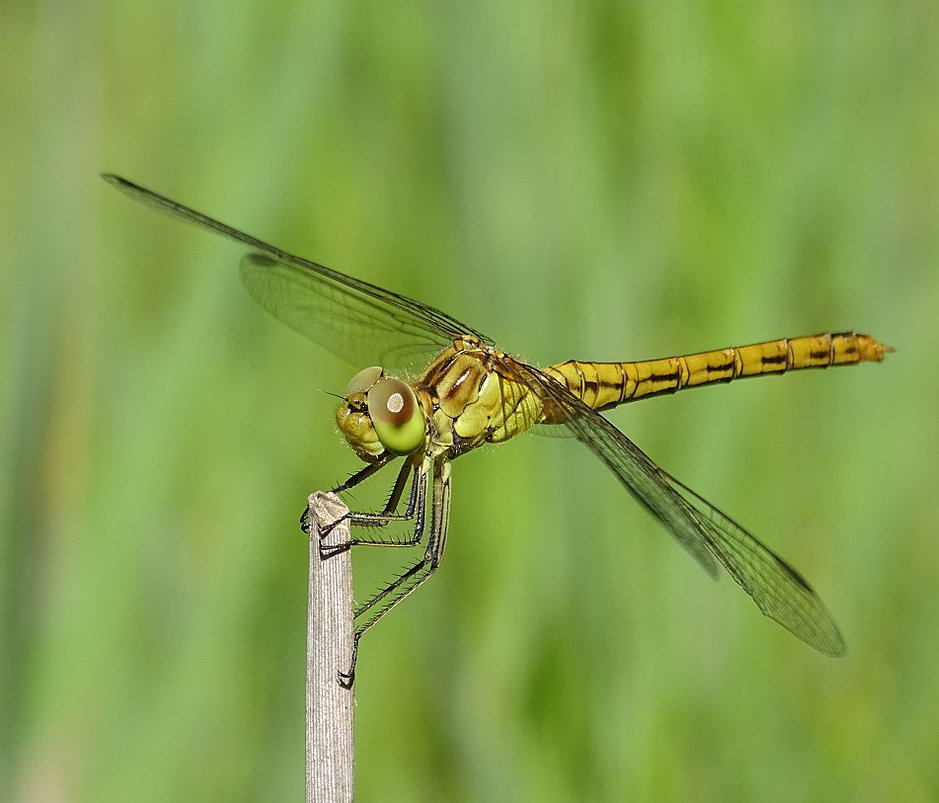
Broad-bodied chaser, Libellula depressa
This is a medium sized but chunky species, with a conspicuously wide abdomen. Adults emerge yellow-brown in colour, maturing to light blue in the male and brown in the female. Mainly occur in southern and central England and Wales, and in flight from April to September. The larvae are slow-growing and can take three years before emerging. Mainly southern England and Wales.
.jpg)
_female.jpg)
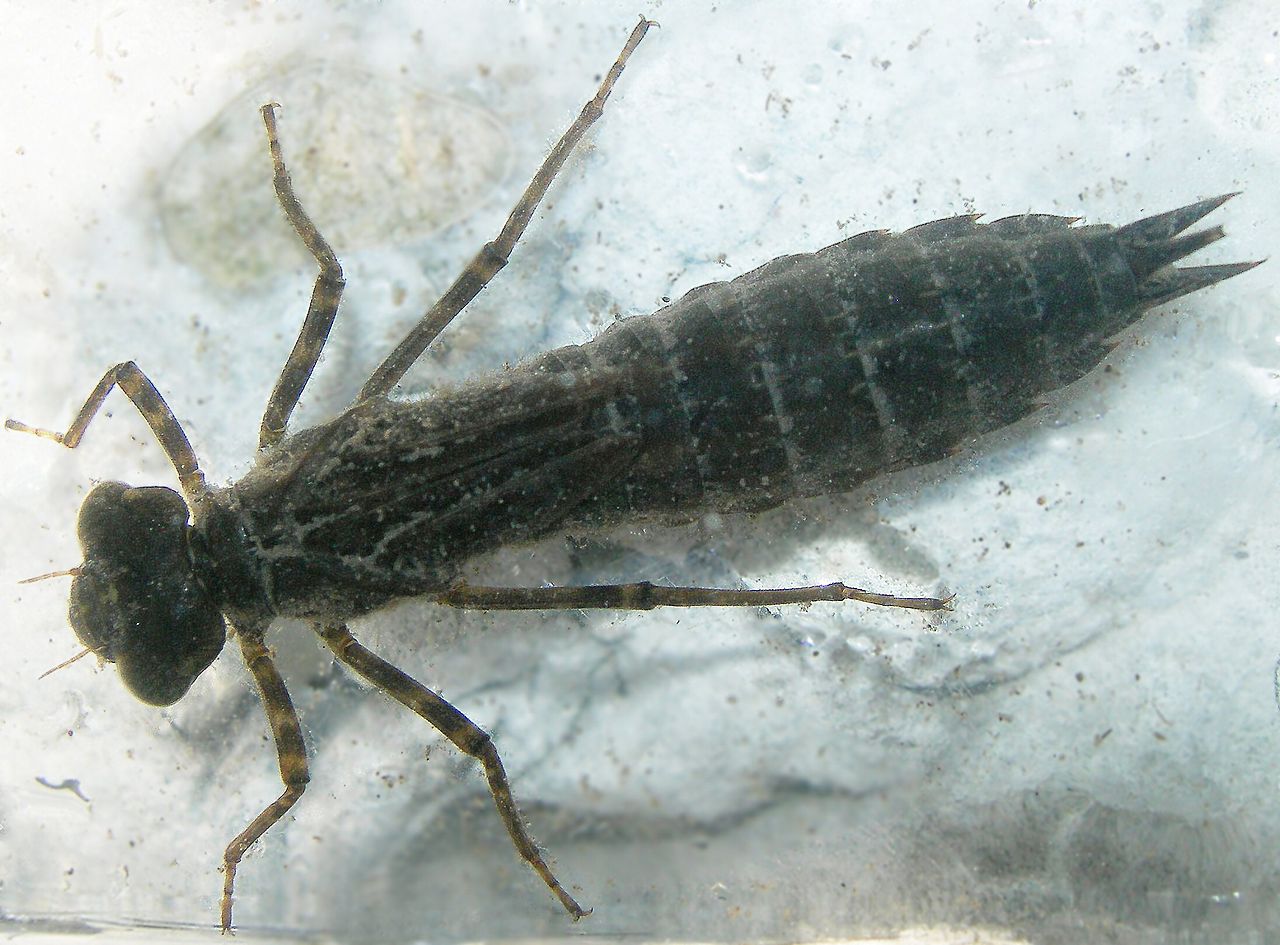
Emperor dragonfly Anax imperator
Top left: male in flight - droopy abdomen
Top right: female
Left: Larva
Four-spotted chaser, Libellula quadrimaculata
This species is found throughout Britain and Ireland but is less likely to be seen in gardens than the broad-bodied chaser. Males and females look similar with a golden-brown colour palette and diagnostic four spots on the wings. In flight from April to October.
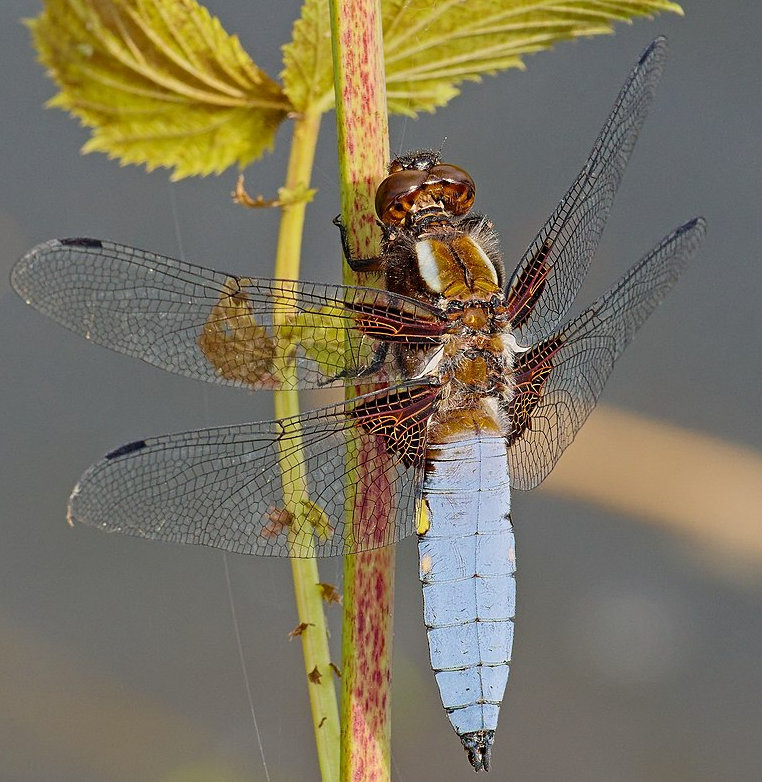
_female.jpg)
_larva,.jpg)
Broad-bodied chaser, Libellula depressa
Top left: mature male
Top right: mature female
Left: Larva
Keeled skimmer, Orthetrum coerulescens
Jennifer Owen recorded this insect in her Leicester garden, but it occurs mainly in wet heathland and peaty areas, flying in May to September. It is similar in appearance to the broad-bodied chaser, with blue-bodied mature males, and yellow-brown females, but the abdomen is much slimmer, and the body is slightly shorter. The insects have a dorsal keel on the abdomen
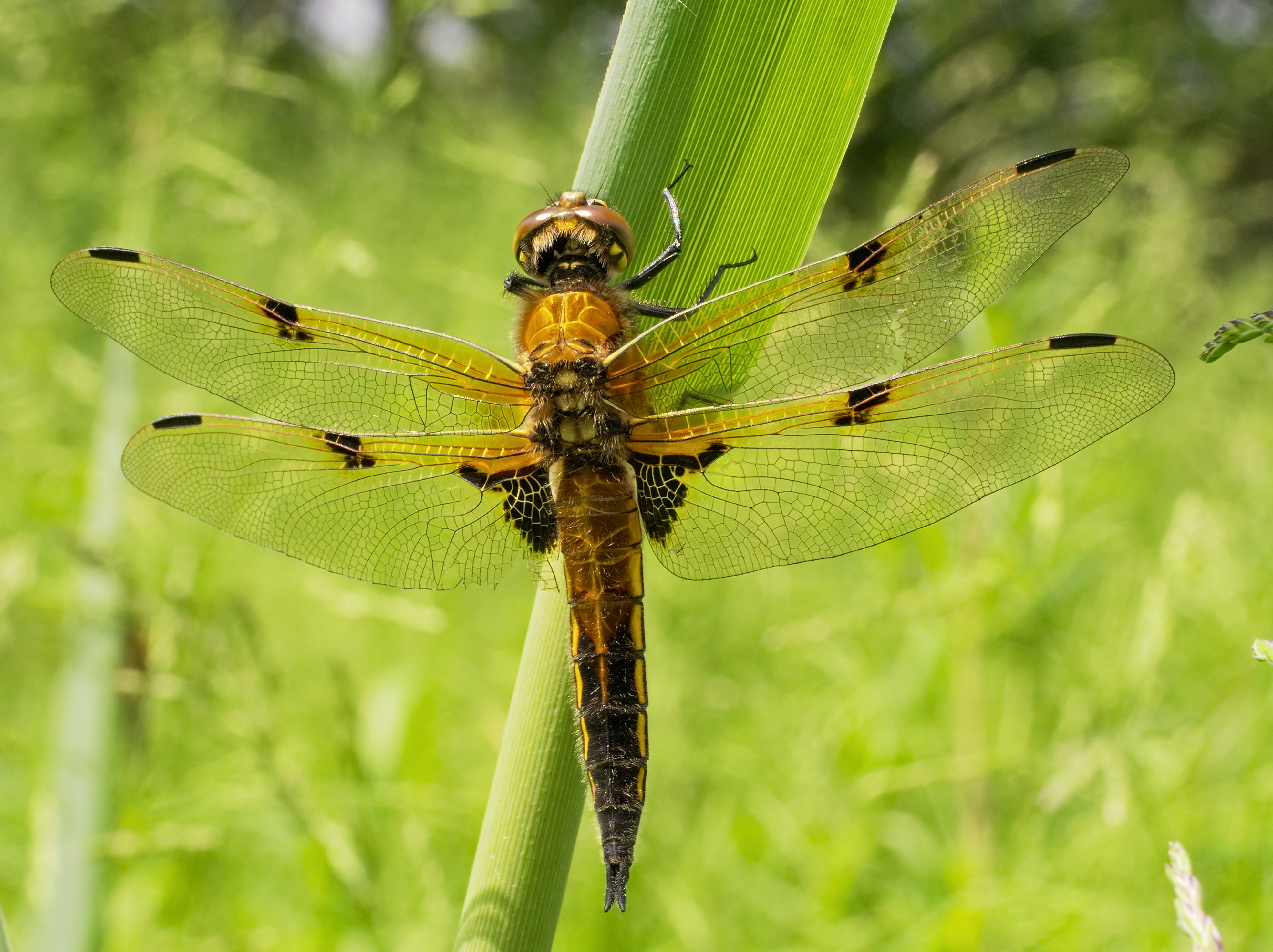
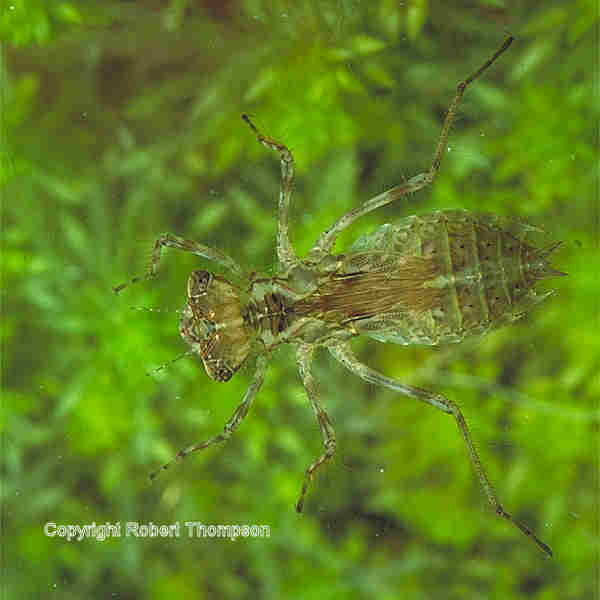
Common darter Sympetrum striolatum. Top left: mature male (ahead) and female in tandem mating flight. Top right: immature adult with yellow-brown colour.
Left: Larva. We are very grateful to Robert Thompson Photography for permission to include this photo.
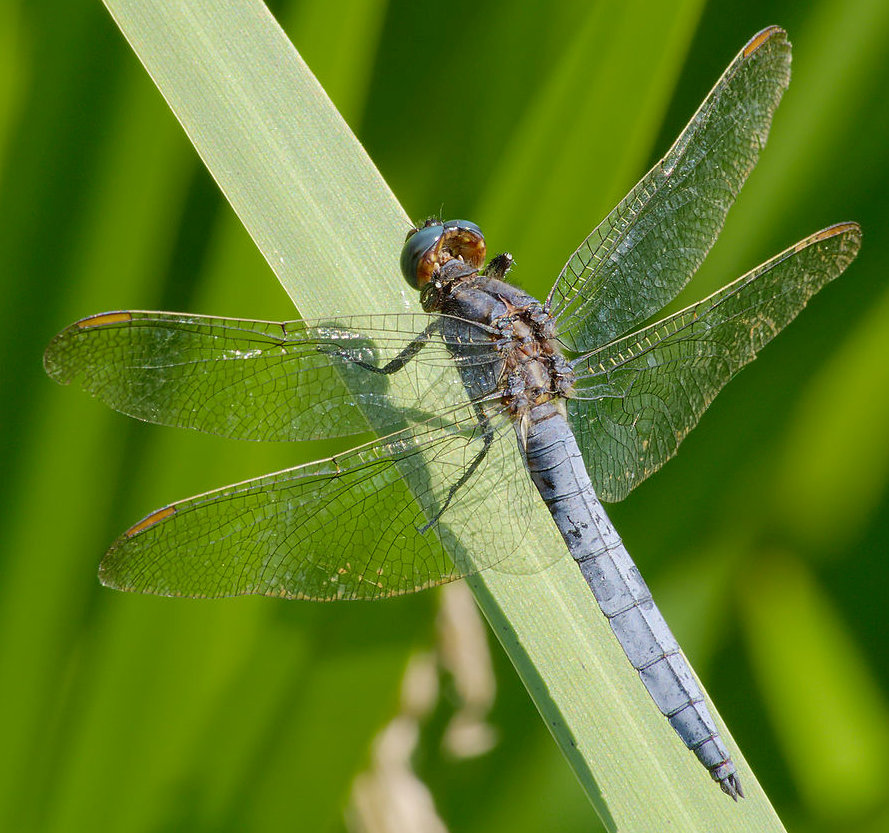
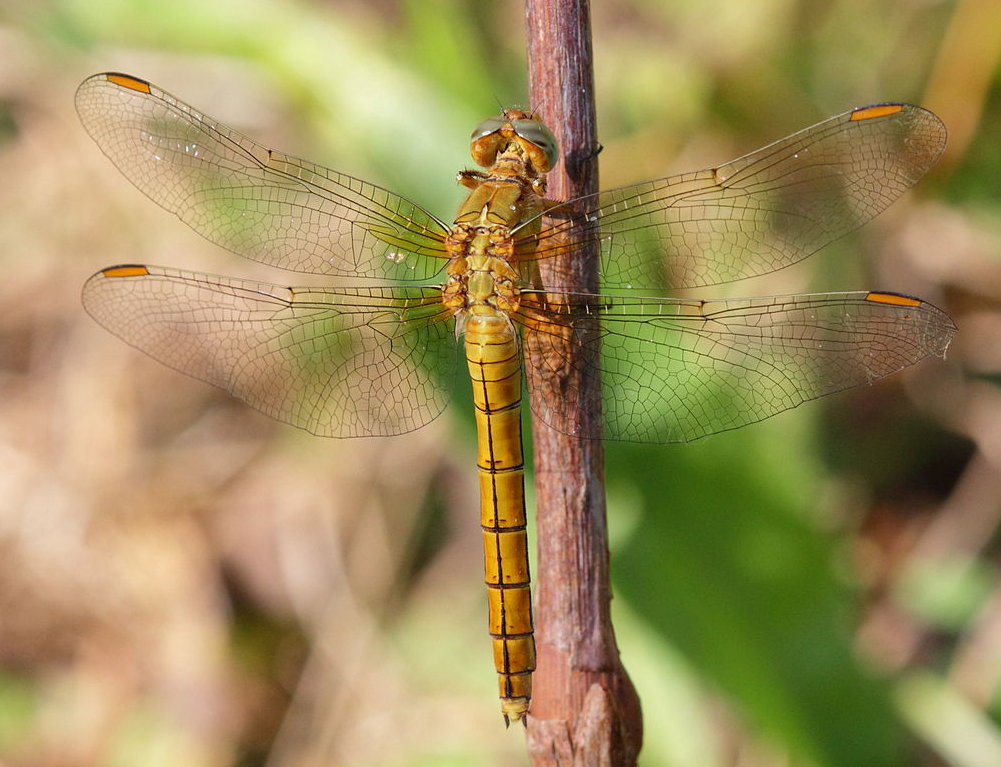
Dragonflies
Dragonflies are insects in the order Odonata, sub-order Anisoptera. They include some of our largest insects by wing span. Dragonflies are generally bigger, more stoutly built and and much stronger fliers than the related damselflies. They are therefore more likely to be seen hunting away from ponds and rivers. Jennifer Owen recorded six species in her garden study, all included below. See our introduction page for more on the biology of these attractive insects.
Species in Britain and Ireland
There are about 30 species of dragonflies in Britain and Ireland. As with damselflies, many species require lakes or running water for breeding, so only a few species can breed in gardens, although some of the other species may visit occasionally.
Southern hawker Aeshna cyanea
This large dragonfly is common in England and Wales, and often seen in gardens from May to early November. They have two large light green patches on the front of the thorax. Females are green and dark brown, while the males have blue, green and black. Note that this genus used to be spelled as "Aeschna"



Southern hawker Aeshna cyanea
Top left: Male showing light green thorax patches
Top Right: Female
Left: Larva
Brown hawker Aeshna grandis
Another large dragonfly distinguished by its light-brown tinted wings and rather plain brown body. Found in southern and eastern England and across Ireland, flying from July to October. Males have a little blue on their abdomen, just in front of a curious "waist"


_larva.jpg)
Brown hawker Aeshna grandis
Top left: Male showing blue thorax patches and "waist"
Top Right: Female laying eggs - the brown wih colour is clear.
Migrant hawker Aeshna mixta. Left: male Right: mating pair, the male clasping the female's head with the tip of its abdomen, while the female takes sperm from the male's abdomen.
Common darter Sympetrum striolatum.
This is a very common smaller dragonfly. As the name implies, they tend to fly out from a resting spot rather than "hawking" - looking for prey in flight. They are seen from May to December, and their numbers are boosted by late summer migrants from Europe. Mature males orange-red and females olive green, but both are yellow-brown as young adults.


Migrant hawker Aeshna mixta The smallest of our garden hawker dragonflies, but often very common, flying in July to November. Both sexes are brown, with the female having yellow spots and the male blue. Both sexes have an extended yellow mark the shape of a golf tee at the front of the abdomen. Found in lowland England and Wales and south Ireland, and its range is expanding north
Emperor dragonfly Anax imperator
This is our largest dragonfly, mainly found in the south of England and Wales, but its range is expanding north and into Ireland. The male is bright blue and female green. They spend up to 2 years as larvae and grow big enough to catch tadpoles and small fish. Adults fly from May to October, and seldom settle, feeding on the wing. The abdomen tends to droop in flight which helps identification.

Common darter Sympetrum striolatum. Top left: mature male (ahead) and female in tandem mating flight. Top right: immature adult with yellow-brown colour.
Left: Larva. We are very grateful to Robert Thompson Photography for permission to include this photo.


Broad-bodied chaser, Libellula depressa
This is a medium sized but chunky species, with a conspicuously wide abdomen. Adults emerge yellow-brown in colour, maturing to light blue in the male and brown in the female. Mainly occur in southern and central England and Wales, and in flight from April to September. The larvae are slow-growing and can take three years before emerging. Mainly southern England and Wales.

Emperor dragonfly Anax imperator
Top left: male in flight - droopy abdomen
Top right: female
Left: Larva
.jpg)
_female.jpg)
Four-spotted chaser, Libellula quadrimaculata
This species is found throughout Britain and Ireland but is less likely to be seen in gardens than the broad-bodied chaser. Males and females look similar with a golden-brown colour palette and diagnostic four spots on the wings. In flight from April to October.
Broad-bodied chaser, Libellula depressa
Top left: mature male
Top right: mature female
Left: Larva
_larva,.jpg)

_female.jpg)

Keeled skimmer, Orthetrum coerulescens
Jennifer Owen recorded this insect in her Leicester garden, but it occurs mainly in wet heathland and peaty areas, flying in May to September. It is similar in appearance to the broad-bodied chaser, with blue-bodied mature males, and yellow-brown females, but the abdomen is much slimmer, and the body is slightly shorter. The insects have a dorsal keel on the abdomen


Other sources of information
Websites
Website of the British Dragonfly Society
Facebook group UK Dragonflies and damselflies
Facebook Group British Butterflies Moths and Dragonflies
Books
Smallshire, D and Swash, A (2018) Britain's Dragonflies: A Field Guide to the Damselflies and Dragonflies of Great Britain and Ireland. Wild Guides
Brooks, S., Cham, S. and Lewington, R. (2018) Field Guide to the dragonflies and damselflies of Great Britain and Ireland. Bloomsbury Wildlife Guides
Cham, S. (2012) Field Guide to the larvae and exuviae of British Dragonflies - Dragonflies (Anisoptera) and Damselflies (Zygoptera). British Dragonfly Society
Corbet, P. & Brooks, S. (2008) Dragonflies Collins New Naturalist series no 106. Harper Collins
Page text drafted by Andrew Halstead, reviewed by Andrew Salisbury, compiled by Steve Head












